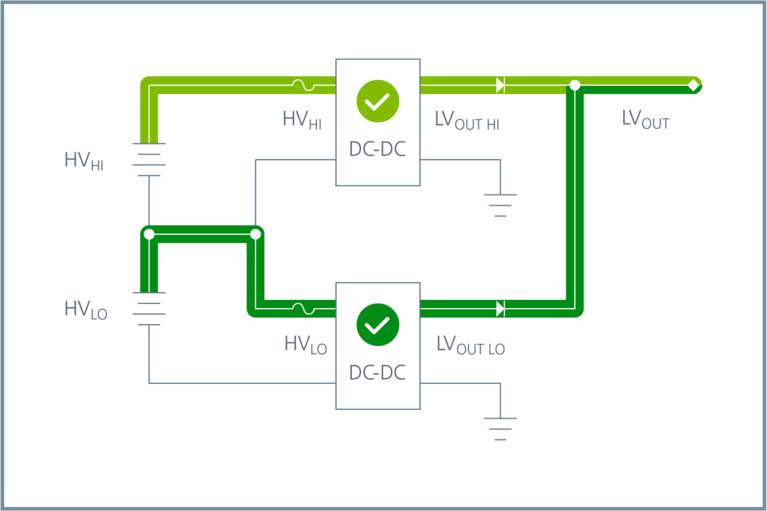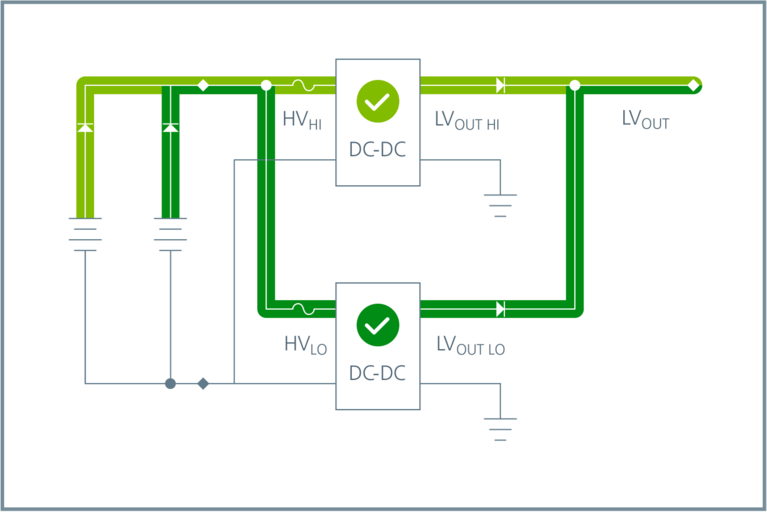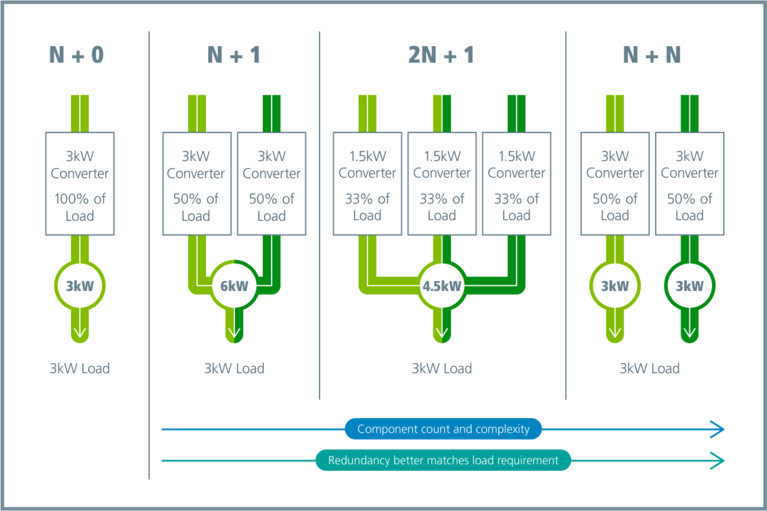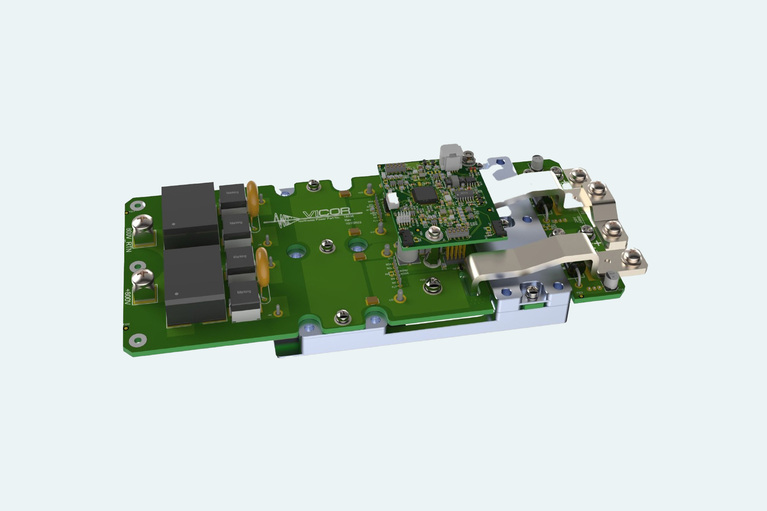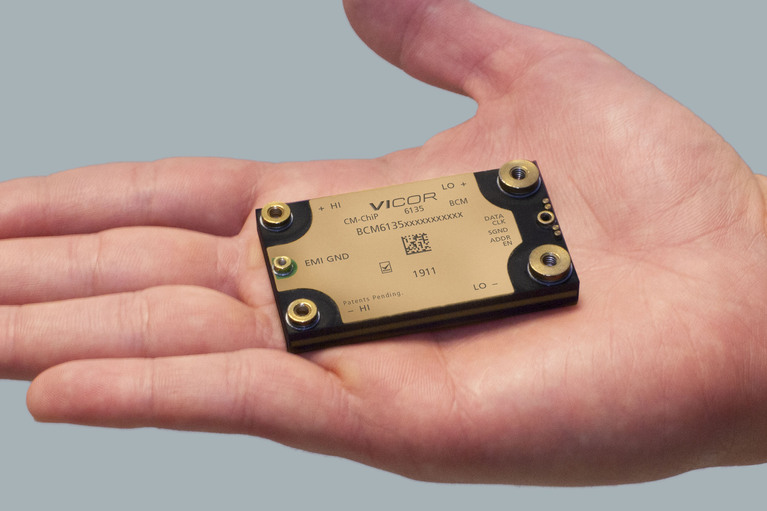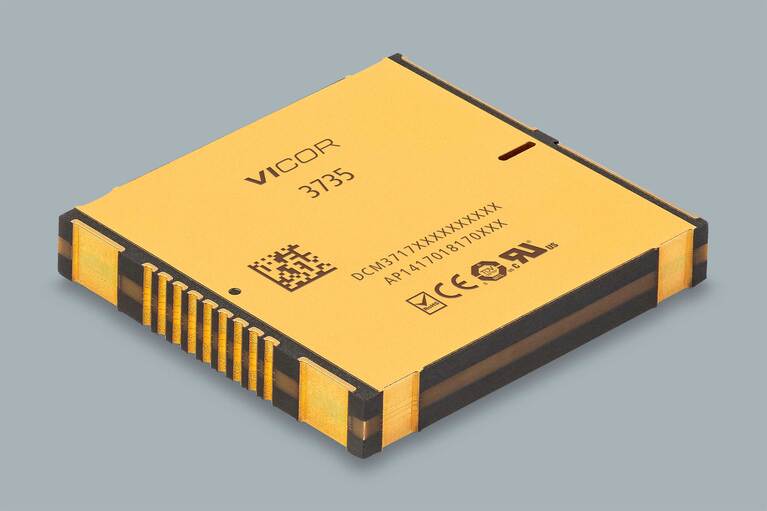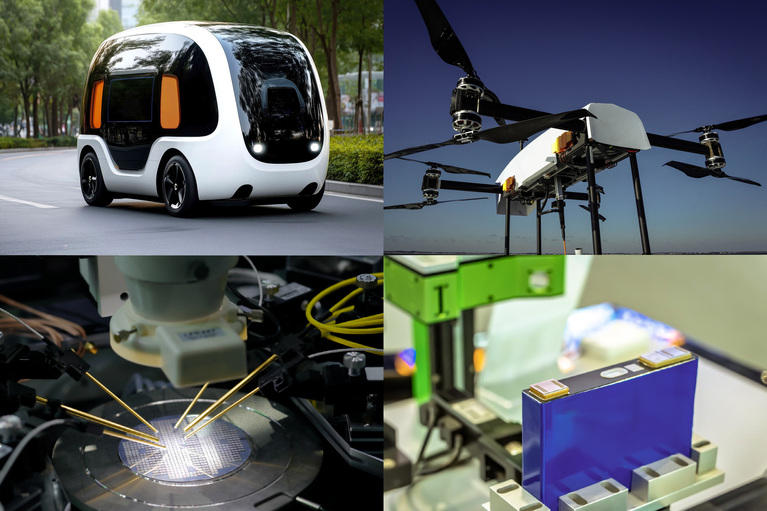
加速进入高性能 48V 供电网络
本电子书提供 48V 供电网络的实用设计指南,旨在提升工业产品性能、效率与可靠性
高紧凑的电源模块开辟了创新的可能性,其性能和可扩展性远优于分立式解决方案。
作者:Patrick Kowalyk,Vicor 公司汽车现场应用工程师(FAE)
全球范围内,电动汽车的销量持续增长。2023 年 3 月,欧洲登记的插电式电动车(包括纯电动汽车和插电式混合动力汽车)总数量超过 322,000 辆,同比增长 29%。此外,纯电动车的销量同比增长 44%,占欧洲汽车销售总量的 16%。[1]
这些数据对所有汽车制造商来说都是好消息,尤其是在经历 2020-2021 年新冠肺炎疫情期间汽车销售低谷之后。整体销量的反弹和电动车销量的显著增长预示着光明的未来前景。然而,消费者对充电基础设施和电池续航里程仍心存疑虑。为此,制造商已开始生产第二代电动车型,以消除消费者的后顾之忧。
有几个值得关注的趋势:
尽管如此,业界仍亟需安全性和可靠性方面的其他重要改进。不可否认,纯电动汽车的所有电源来自单一高压牵引电池,任何电源中断不仅会带来不便,还可能造成严重的安全隐患。尽管舒适性功能目前正吸引消费者并刺激销售,但电动汽车平台的长期生存有赖于设计并采用合理的安全协议。因此,对所有电动汽车而言,电源冗余至关重要。
在电动汽车中增加冗余电源,可确保驾驶员、乘客及其他道路使用者的安全,提高可靠性。下面所列的三种负载尤其需要冗余电源:
例如,通过串联两个 400V 电池组,并为每个电池配置独立的 DC-DC(400V 至 800V)转换器,电动汽车电源架构师可以实现 800V 的牵引电池电源。这种配置(如图 1 所示)被称为双 400V 串联堆叠系统。
图 1:双 400V 串联堆叠系统:堆叠架构将两个 400V 电池组串联起来并配备独立的 DC-DC 转换器,可实现低电压运行并将负载分配到两条或多条线路上。
出于几个方面的原因,一些制造商目前已开始采用双 400V 串联堆叠系统。主要原因是使用 400V 充电器充电更方便,因为许多现有的公用充电桩不兼容 800V 电压。如今,越来越多的新装充电桩能够同时支持 400V 和 800V 电池。其次,如果制造商已经设计并认证了 400V 电池组,串联两个电池组更加快捷简便。
另一种方法是双 800V 并联电池配置(如图 2 所示),即并联使用两个 800V 电池。这种方法也通过两个独立的 DC-DC 转换器提供冗余。
图 2:双 800V 并联电池配置:这种配置允许低电流运行,更容易实现 N+1 冗余。
这两种配置各有利弊。
使用双 400V 串联堆叠系统时需要考虑的缺点包括:
这种系统的优点包括:
同样,双 800V 并联电池配置也是有利有弊。
优点:
缺点:
尽管目前使用双 800V 电池平台的汽车较少,但这种方法提供的冗余对车辆安全至关重要。如果没有冗余,最重要的汽车系统一旦短路就可能引发灾难性事件。电动汽车的电源架构正朝着这个方向发展。可靠性和安全性是促使汽车制造商进行迁移的最重要原因,而新型充电器可兼容 400V 和 800V 两种电压,进一步凸显了市场对 800V 的需求。
不同因素可能促使人们选择某种方法而非另一种,但在大多数情况下,双 800V 电池配置因一个简单的原因而更受欢迎:该系统中,电源模块可通过并联电池轻松实现冗余。这样,如果发生短路,可以通过另一套电源为负载供电,防止系统完全关闭。
除了容纳两个电池组所需的物理空间外,还需考虑重量和续航里程。虽然电池管理系统需要一些额外的电路,但从整体来看,安全性和可靠性带来的优势远超这些成本。
实现电源冗余的方式有很多种(如图 3 所示)。负载可以同时连接到两个或多个 DC-DC 转换器,如果一个电源或转换器出现故障,另一个转换器能够接替运行全部负载。为电动汽车设计稳健可靠的电源架构是一项极具挑战性的任务。然而,通过引入电源冗余,汽车制造商就可以提升车辆的安全性和可靠性,更重要的是可以增强消费者的信心。
电源冗余可以通过多钟形式实现。审视从电源到负载点的整个电源链并提问:若此位置或电路部分发生故障,电源冗余可以通过多钟形式实现。审视从电源到负载点的整个电源链并提问:若此位置或电路部分发生故障,
电源冗余设计的目标是确保车辆能够继续行驶或安全地驶离高速公路匝道。
DC-DC 转换器的冗余形式多样(如图 3 所示),例如 N+0、N+1、2N+1 等。每种配置在尺寸、成本和复杂性方面各有优缺点,需针对每种汽车架构进行仔细研究。
图 3:多种冗余架构组合展示了电动汽车动力系统中的功率水平和功率分配。N+1 方案具有更出色的功率能力,因此可能是更大、更昂贵的解决方案。从左到右,冗余度逐渐提高,电源供应更贴近负载需求,但组件数量和系统复杂性也随之增加。
使用双向 DC-DC 转换器并分离车辆负载,就可以将电源从一个区域传递到另一个区域。通过稳压器供电,可为负载提供稳定的电源,甚至可以为电池充电。
然而,当前的转换器技术还不够先进,无法使 DC-DC 转换器足够小巧而轻便,以在纯电动汽车中并联使用多个转换器。
Vicor 的 BCM® 和 DCM™ 电源模块可以轻松并联。它们外形小巧,可以减少 DC-DC 转换器的整体占用空间,而高效率和高密度有助于提升性能(如图 4 所示)。这样就可以延长车辆续航里程,支持新架构以增强安全性。
图 4:这个 4kW DC-DC 转换器使用 2 个 Vicor BCM6135 和 2 个 DCM3735(位于电路板底部),将 800V 电源转换为 12V 电源,封装重量仅 0.08 千克,体积仅 0.8575 升。此配置可分为 2 套 2kW 的冗余电源,或与另一单元并联,打造 4kW 的冗余电源。
高密度电源模块开启了一系列创新机会,以远超分立式解决方案的方式提供出色性能和可扩展性。这些电源模块提供高达 3 倍的功率密度,便于扩展,并提供更高的瞬态速度,因此可以帮助缩小或彻底淘汰 12V/48V 辅助电池。BCM(如图 5 所示)能够降低高压侧电压并增加电流,同时在高功率密度、高效的转换器中提供隔离功能。
图 5:BCM® 母线转换器。BCM 是高密度、高效率、固定比率(非稳压)隔离式 DC-DC 转换器模块。该系列涵盖从 800V 或 400V 至 48V 的输入,支持多种 K 因子,适用于广泛的应用。BCM 可在从高压电池电压转换到低压网络电压的过程中提供最高的功率密度。BCM 产品系列采用 Vicor 的正弦振幅转换器™(SAC™)技术,在小型化模块中实现高效率和高性能。Vicor 开发可用于 400V 或 800V 电池的 BCM,而且可通过阵列的形式使用,满足多种电源需求。
BCM 是一种比例式器件,其输出电压与输入电压成比例,根据 K 因子计算得出。例如,若电源为 800V 并联配置,K 因子为 1/16,则低压侧电压为高压侧电压除以 16,而输出电流则为高压侧电流乘以 16。双 400V 串联堆叠系统使用类似的 BCM,但 K 因子为 1/8。
图 6:DCM3735 是非隔离式稳压 DC-DC 转换器,输入范围为 35-58V。它提供恒定的电流以便为电池充电,采用紧凑的封装(36.6 x 35.4 x 7.4 毫米),能以阵列方式使用。
DCM3735 稳压器从 BCM 获取电压并提供严格稳压的输出,可以为电容器或电池充电(如图 6 所示)。结合使用BCM 和 DCM,设计师就可以灵活地设计占用空间小、重量轻的高效电动汽车冗余电源网络。Vicor技术可在不到 0.9 升的空间内提供 4kW 的 800V 至 12V 电源。如图 4 所示,该系统重量不到 1 千克,而且可以通过缩小 12V 备用电池实现进一步减重。
消费者想购买电动车,但许多人心存疑虑,他们最担心的问题是续航里程和充电便利性。这些问题不易解决,但电源架构和功率密度领域的创新成果正在改变这一局面。紧凑的电源架构可以减轻重量,增加续航里程。此外,电源模块的引入扩展了创新空间,帮助更轻松地减小尺寸,减轻重量,从而进一步增加续航里程。
电源模块对于解决续航里程、可靠性和安全性等问题至关重要。出色的可扩展性和小巧的尺寸为设计电源系统带来了巨大的灵活性。与创新的电源架构结合使用时,电源模块已成为加速当今纯电动汽车长期普及的催化剂。
资料来源:
[1] Kane,Mark(2023 年 5 月 10 日),《欧洲:2023 年 3 月插电式电动汽车销量猛增》,INSIDEEVS
Patrick Kowalyk 从事汽车电源系统研发已有 6 年多的时间,而且是一位拥有数十年实践经验的工程师。Patrick 拥有深厚全面的技术知识,为推动 Vicor 的汽车业务发展做出了重大贡献。他精通电源模块、拓扑结构和架构方面的技术,在业内可谓无人能及。Kowalyk 一直致力于帮助 OEM 厂商和顶级供应商客户设计紧凑、高效的电源系统。他毕业于伊利诺伊理工学院,获得了电气工程学士学位。
Patrick Kowalyk,汽车现场应用工程师

